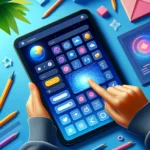Introduction
Material Design is a design language created by Google, emphasizing clean, responsive layouts, bold colors, and intuitive user interactions. Flutter, also developed by Google, has built-in support for Material Design, making it easy to create beautiful, consistent UIs for your applications. This guide will walk you through the essential steps to implement Material Design in your Flutter apps.
Table of Contents
- Understanding Material Design
- Setting Up a MaterialApp
- Using Material Components
- Customizing Themes
- Creating Custom Widgets
- Best Practices
- Conclusion
Understanding Material Design
Material Design is based on principles of tangible surfaces, bold graphics, and meaningful motion. It aims to create a unified user experience across all platforms and devices. Key elements of Material Design include:
- Surfaces and Shadows: Use of surfaces, shadows, and elevations to create depth.
- Bold Colors: Vibrant and bold color schemes.
- Responsive Design: Adaptive layouts for different screen sizes and orientations.
- Meaningful Motion: Smooth transitions and animations to guide the user.
Setting Up a MaterialApp
To get started with Material Design in Flutter, you need to wrap your app in a MaterialApp widget. This provides the basic Material Design structure and theming capabilities.
dartCopy codeimport 'package:flutter/material.dart';
void main() {
runApp(MyApp());
}
class MyApp extends StatelessWidget {
@override
Widget build(BuildContext context) {
return MaterialApp(
title: 'Material Design App',
theme: ThemeData(
primarySwatch: Colors.blue,
),
home: HomeScreen(),
);
}
}
class HomeScreen extends StatelessWidget {
@override
Widget build(BuildContext context) {
return Scaffold(
appBar: AppBar(
title: Text('Home'),
),
body: Center(
child: Text('Welcome to Material Design in Flutter!'),
),
);
}
}
Using Material Components
Flutter provides a wide range of Material Design components out of the box. Here are some commonly used components:
AppBar
The AppBar widget is used to create a material design app bar.
dartCopy codeAppBar(
title: Text('App Bar'),
actions: [
IconButton(
icon: Icon(Icons.settings),
onPressed: () {},
),
],
)
FloatingActionButton
The FloatingActionButton is used to create a circular button that hovers over the content.
dartCopy codeFloatingActionButton(
onPressed: () {},
child: Icon(Icons.add),
)
Card
The Card widget is used to create material design cards.
dartCopy codeCard(
child: ListTile(
leading: Icon(Icons.album),
title: Text('Material Card'),
subtitle: Text('This is a card.'),
),
)
ListTile
The ListTile widget is used to create material design list items.
dartCopy codeListView(
children: [
ListTile(
leading: Icon(Icons.map),
title: Text('Map'),
),
ListTile(
leading: Icon(Icons.photo),
title: Text('Photo'),
),
ListTile(
leading: Icon(Icons.phone),
title: Text('Phone'),
),
],
)
Customizing Themes
Flutter allows you to customize the look and feel of your app using themes. You can define a custom theme for your app by configuring the ThemeData class.
Define a Custom Theme
dartCopy codeMaterialApp(
title: 'Custom Theme App',
theme: ThemeData(
primarySwatch: Colors.teal,
accentColor: Colors.orange,
textTheme: TextTheme(
headline1: TextStyle(fontSize: 24, fontWeight: FontWeight.bold),
bodyText1: TextStyle(fontSize: 14),
),
),
home: HomeScreen(),
)
Use the Custom Theme
dartCopy codeText(
'Custom Themed Text',
style: Theme.of(context).textTheme.headline1,
)
Creating Custom Widgets
Creating custom widgets that follow Material Design guidelines ensures consistency and reusability across your app.
Custom Button Widget
dartCopy codeclass CustomButton extends StatelessWidget {
final String label;
final VoidCallback onPressed;
CustomButton({required this.label, required this.onPressed});
@override
Widget build(BuildContext context) {
return ElevatedButton(
onPressed: onPressed,
style: ElevatedButton.styleFrom(
primary: Theme.of(context).accentColor,
onPrimary: Colors.white,
padding: EdgeInsets.symmetric(horizontal: 20, vertical: 15),
textStyle: TextStyle(fontSize: 16),
),
child: Text(label),
);
}
}
Using the Custom Button
dartCopy codeCustomButton(
label: 'Click Me',
onPressed: () {
// Handle button press
},
)
Best Practices
- Consistent Styling: Use themes to ensure consistent styling across your app.
- Responsive Design: Adapt layouts for different screen sizes and orientations.
- Use Material Components: Leverage built-in Material components for standard UI elements.
- Follow Guidelines: Adhere to Material Design guidelines for best results.
Conclusion
Implementing Material Design in Flutter is straightforward, thanks to Flutter’s rich set of built-in Material components and customizable theming options. By following the steps and best practices outlined in this guide, you can create beautiful, consistent, and responsive UIs that enhance the user experience. Happy coding!
